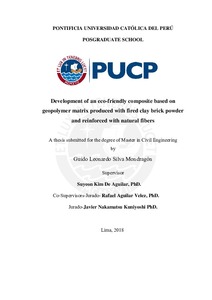Development of an eco-friendly composite based on geopolymer matrix produced with fired clay brick powder and reinforced with natural fibers
Abstract
Current construction industry is responsible for a large amount of greenhouse gas
emissions due to the widespread use of building materials with high-embodied energy
such as ordinary Portland cement-based materials and steel. Therefore, this thesis
presents the development of a new eco-friendly building material based on a
geopolymer matrix produced with Fired Clay Brick Powder (FCBP) and reinforced
with natural fibers as a low CO2 alternative for the traditional building materials.
With this purpose, a review of recent advances in the application of geopolymer
composites and geopolymers reinforced with natural fibers in the construction industry
were first presented. This review covers two major eco-friendly materials for
construction: first, geopolymers obtained from industrial by-products and waste
materials, such as fly ash, ground granulated blast furnace slag, construction and
demolition wastes and main tailings; and second, natural fibers used as reinforcement
for geopolymer composite materials. Literature review allowed the definition of
morphology, size, and the molar ratio of SiO2/Al2O3 in the raw material, together with
the alkaline solution/solid ratio, NaOH concentration, SiO2/M2O molar ratio in the
total alkaline solution and the curing conditions as key parameters in the formulation
of geopolymers. It has been also found that the type, pre-treatment, amount and length
of the natural fibers play an important role in the reinforcement of geopolymer
matrices. Once key parameters of geopolymer composites production were identified,
an attempt for the formalization of a methodology to improve the compressive strength
of FCBP-based geopolymers is presented. The tests allowed the definition of optimum
conditions of the FCBP-based geopolymers formulation and curing conditions, which
resulted in a cementitious matrix with high compression strengths of up to 37 MPa.
Nevertheless, high-strength geopolymers evidenced a fragile behavior and low
ductility similar to Portland cement-based materials. Therefore, the last part of the
work was focused on the evaluation of natural cellulose fibers (jute and sisal) as
reinforcement of FCBP-based geopolymers. The results indicated that jute and sisal
fiber addition at the optimum content significantly improved the compressive, splitting
tensile and flexural strength with respect to the unreinforced geopolymer matrix and
lead to a shifting of the failure mode from a brittle to a more ductile failure in all
mechanical tests.
Temas
Polímeros inorgánicos
Polímeros inorgánicos--Producción
Arcilla
Polímeros inorgánicos--Producción
Arcilla
Para optar el título de
Maestro en Ingeniería Civil
Collections
The following license files are associated with this item:






